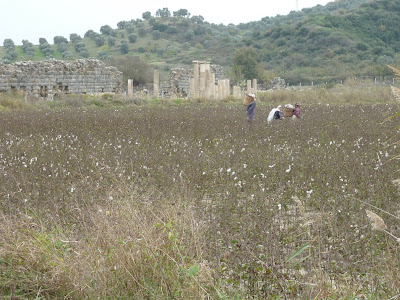It was at Priene, another Ionian League city, that Vicki articulated her "great houses" theory of touring classical ruins. In the UK of GB, a year ago, we toured dozens of the great houses. (We had National Trust and English Heritage passes). Yes, they all have certain similarities: big houses, great halls, art work, parks, grounds, gardens, follies. Taking a little more time with them, as we did, we began to see more of the historical/cultural/political/regional/other nuances. They are all quite different and quite interesting, despite the superficial similarities. (There is also a similar approach to touring cathedrals...). Anyhow, we have now attained that state where, despite the same old stones, theatres, stadia, agora, baths, nymphanea, etc., we are beginning to see each of these ruins as quite distinct and different. Of course they can't have the richness that great houses have with all their furniture, decorative arts, landscaping, recent history, familiarity, etc. (Museums can supply some of this for the ancients). But I digress.
Priene was not a coastal city but was rather well up the Menderes Valley, perched on a hilltop at the foot of Mt. Mykales' great face. As an Ionian League city, it could trace its origins to the Greek colonists who settled many of these places, sometime around 1,000 BCE. For whatever reasons, the Romans were never attracted to Priene; its influence waned, and, by Byzantine times, it was abandoned. And so it remains one of the very best examples of a purely Greek/Hellenistic city. And it is relatively well preserved.
 |
Here's what archaeologists think it looked like, in its hey-day
|
 |
Columns of Priene's Temple of Athena, 4th century BCE
|
 |
Column-building is quite elementary, you see; you just
match "A" to "A" and "B" to "B" and then proceed on up
until finished
|
 |
Menderes Valley from Priene
|
 |
"Greek to me" department
|
 |
Main Street; agora
|
 |
Every now and then, you see a really nice day-pack-sized
fragment in a conspicuous place; bait for would-be
smugglers we think...
|
 |
Priene's Greek theatre
|
 |
VIP seating and the central altar; theatre for the Greeks was
far more a religious experience than entertainment, hence,
the altar, for sacrifices
|
 |
Me on the altar; Dionysus knows I am one of his best
customers
|
 |
Priene's Temple to Egyptian Gods
|
 |
Vicki leaving via the city's main gate
|


















































